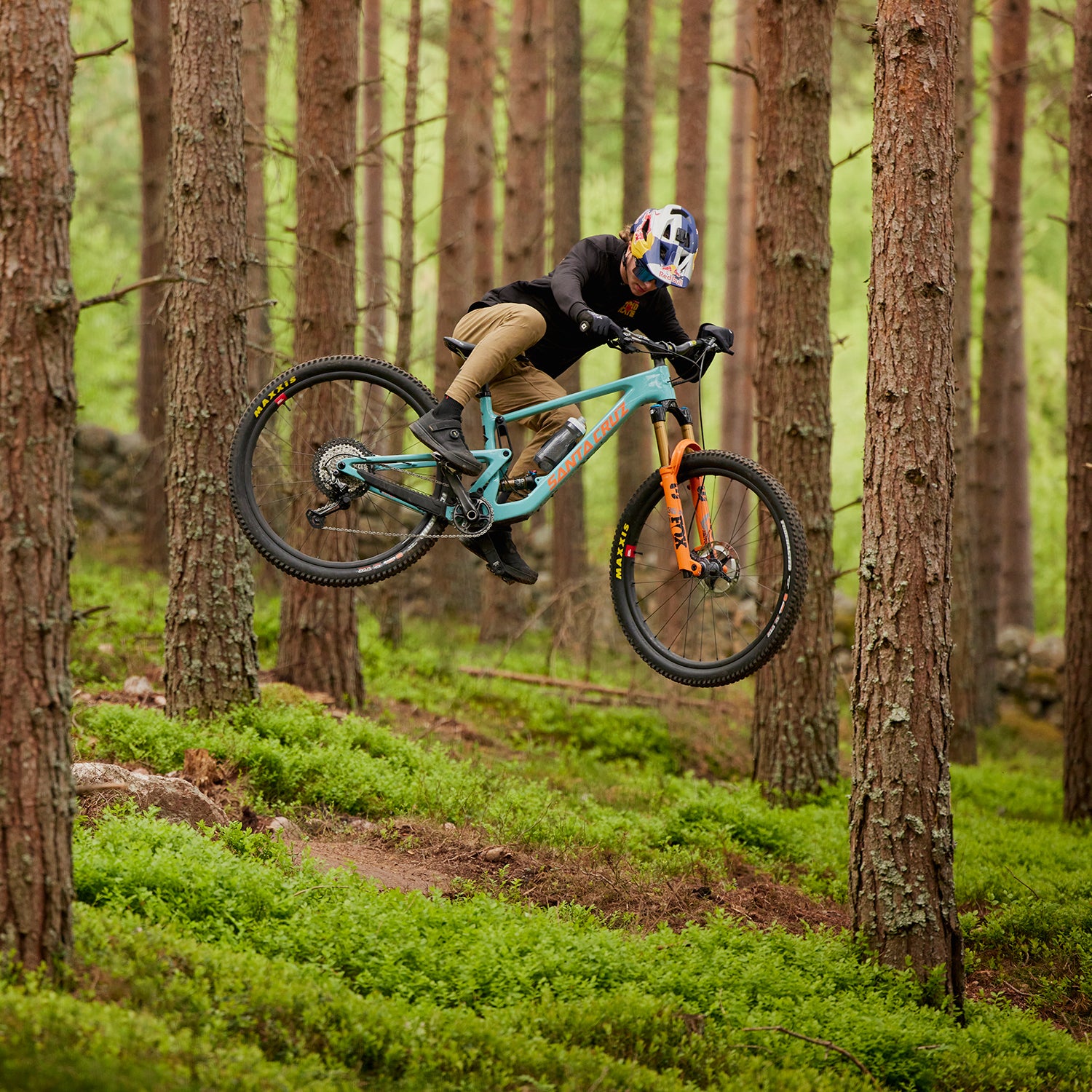To be a good mountain biker, focus on building core strength, improving your handling skills, and regularly practicing on various terrains. Mountain biking is an exhilarating sport that combines physical fitness, technical finesse, and a love for adventure.
Whether you’re a beginner or an experienced rider, becoming a proficient mountain biker requires dedication and a commitment to continually enhance your skills. We will explore some essential techniques and strategies that can help you elevate your mountain biking abilities.
By following these tips, you will be able to navigate challenging trails, conquer obstacles, and experience the sheer thrill of shredding through the mountains. So, grab your helmet, tighten your shoelaces, and get ready to become a good mountain biker.
Choosing The Right Mountain Bike
When it comes to mountain biking, choosing the right bike can make all the difference in your riding experience. Whether you are a beginner or an experienced rider, finding the perfect mountain bike for your needs is essential. In this article, we will explore the key factors to consider and understand different types of mountain bikes, helping you make an informed decision.
Consider Your Riding Style
Before diving into the world of mountain bikes, it is important to consider your riding style. Do you prefer smoother trails or are you more inclined to tackle rough, technical terrains? Understanding your riding style will help you determine the specific features and components that are ideal for your needs.
In addition to your riding style, also consider the type of trails you will be riding on. Will you be mainly riding on cross-country trails, downhill tracks, or a combination of both? This will further narrow down the type of mountain bike that is best suited to your needs.
Understand Different Types Of Mountain Bikes
To make an informed decision when choosing a mountain bike, it is important to understand the different types available. Here are the main types of mountain bikes:
| Type | Description | Best For |
|---|---|---|
| Cross-Country | Designed for efficiency and speed on smoother, less technical trails. | Beginners or riders who prioritize climbing and covering long distances. |
| Trail | Offers a balance between climbing ability and descending skills, suitable for a variety of terrains. | Intermediate riders who enjoy a mix of climbing and descending. |
| All-Mountain/Enduro | Designed for aggressive descending, with improved suspension and durability. | Advanced riders who prioritize technical descents and challenging trails. |
| Downhill | Specifically built for downhill racing, with maximum suspension travel and downhill performance. | Riders focused on extreme downhill descents and high-speed races. |
By understanding the different types of mountain bikes and their intended use, you can narrow down your options and choose the one that best suits your riding style and preferences.
Remember, when choosing a mountain bike, it is essential to test ride different models and sizes to ensure a proper fit and comfort. Invest time in researching and consulting with experts to make an informed decision. With the right mountain bike by your side, you can confidently hit the trails and enjoy an exhilarating ride!

Credit: www.bikeradar.com
Essential Gear And Equipment
Before hitting the trails on your mountain bike, it’s crucial to have the right gear and equipment to ensure a safe and enjoyable ride. From helmets to clothing, each piece plays a vital role in your biking experience.
Selecting The Right Helmet
A properly fitting helmet is a non-negotiable when it comes to mountain biking. Look for certified helmets that offer ample ventilation and adjustable straps for a secure fit.
Choosing Appropriate Clothing
Wearing moisture-wicking clothing helps to keep you comfortable and dry during your ride. Opt for padded shorts to reduce saddle soreness and durable materials that can withstand the elements.
Mastering Trail Riding Techniques
Trail riding is a thrilling and challenging adventure that requires a combination of skill, precision, and confidence. To become a good mountain biker, it is essential to master the various trail riding techniques. With the right body position, an understanding of braking and shifting, and a focus on safety, you can enjoy a smooth and exhilarating ride through any terrain.
Learning Proper Body Position
Proper body position is crucial for maintaining balance, control, and stability while navigating through trails. By keeping your weight centered and distributed evenly on the bike, you can tackle obstacles and corners effectively.
- Keep your knees slightly bent and elbows relaxed
- Shift your weight backward on descents to maintain control
- Lean forward with your elbows out to maintain stability during climbs
- Engage your core muscles to enhance balance and control
Understanding Braking And Shifting
Knowing when and how to brake and shift gears is essential for a seamless and efficient trail riding experience. Proper braking techniques allow you to slow down, maintain control, and navigate steep descents or tight corners effectively. Shifting gears smoothly helps you maintain a steady cadence and power through different terrains.
Braking Techniques
When it comes to braking, it is important to use both your front and rear brakes simultaneously for maximum control. However, avoid squeezing them too hard, as this may cause your wheels to lock or lose traction. Gradually apply pressure to the brakes to slow down and modulate your speed smoothly.
Gear Shifting
Understanding when to shift gears can make a significant difference in your trail riding performance. Anticipate upcoming terrain or obstacles and shift gears accordingly. Lower gears are ideal for climbing steep hills, while higher gears offer more speed on flat or downhill sections.
Remember to shift gears one at a time to avoid putting excessive strain on the chain and derailleur. Practice shifting gears while maintaining a steady pedaling motion to ensure smooth transitions.
By mastering these trail riding techniques, you can become a skilled and confident mountain biker. Practice regularly on a variety of trails, gradually pushing your limits and expanding your skill set. Always prioritize safety, wear proper protective gear, and ride responsibly to fully enjoy the thrills of mountain biking.
Trail Maintenance And Safety
Regularly check your bike for any signs of wear and tear to prevent accidents.
Familiarize yourself with trail etiquette and safety rules to ensure a safe biking experience.
Physical And Mental Preparation
Prepare yourself physically and mentally to become a proficient mountain biker. Engage in regular strength and endurance training to improve your physical fitness. Additionally, focus on developing mental toughness and agility to conquer the challenges of mountain biking. By combining both physical and mental preparation, you can excel in this demanding sport.
Building Endurance And Strength
Train regularly by biking on various terrains to enhance stamina. Incorporate strength training exercises like squats and lunges.
Developing Mental Focus And Resilience
Practice mindfulness techniques during rides to stay focused. Embrace challenges as opportunities to grow stronger mentally.
In mountain biking, physical and mental preparation are crucial for success. Building endurance and strength empowers riders to conquer challenging trails. Developing mental focus and resilience enables bikers to overcome obstacles with ease. Regular training and mindfulness practice play a significant role in enhancing biking performance.

Credit: m.youtube.com
Exploring Mountain Biking Communities
When it comes to mountain biking, it’s not just about hitting the trails; it’s also about being part of a vibrant and supportive community. Exploring mountain biking communities can enhance your experience as a rider, introduce you to new trails, and help you develop your skills. Engaging with local groups and organizations can create lasting friendships and open up a world of adventure.
Joining Group Rides And Events
Joining group rides and events is a fantastic way to connect with fellow mountain bikers and dive deep into the local biking scene. It provides an opportunity to bond over a shared passion for mountain biking, learn from others, and discover new trails. Group rides can range from casual social outings to more intense and challenging experiences, catering to riders of all levels.
Engaging With Local Trail Organizations
Engaging with local trail organizations is another avenue to immerse yourself in the mountain biking community. These organizations often lead trail maintenance projects, organize races, and advocate for trail access. By getting involved, you can contribute to the upkeep of the trails you love to ride, network with other riders, and gain a deep understanding of the local biking landscape.
Understanding Bike Repair And Maintenance
Learn the essentials of mountain bike repair and maintenance to become a proficient rider. Mastering these skills ensures you can stay safe and confident on every trail. Understanding the ins and outs of your mountain bike can enhance your riding experience and help you become a better cyclist.
Nutrition And Hydration For Peak Performance
When it comes to conquering mountain bike trails with vigor and enthusiasm, your nutrition and hydration play crucial roles. Fueling your body with the right foods and maintaining proper hydration is vital for peak performance on long rides. In this section, we will discuss effective strategies to fuel your body for long rides and prioritize hydration for trail success.
Fueling Your Body For Long Rides
Before you hit the trails, it is important to fuel your body adequately to ensure sustained energy and endurance. Here are some key tips to consider:
- Carbohydrates: Incorporate a mix of complex carbs to provide your body with the lasting energy it needs. Opt for whole grains, fruits, and vegetables.
- Protein: Consumption of lean proteins, such as chicken, fish, and beans, aids in muscle recovery and growth. Include protein-rich foods in your pre-ride meal.
- Healthy Fats: Don’t shy away from incorporating healthy fats like avocados, nuts, and seeds into your pre-ride nutrition. These will provide a source of long-lasting energy.
- Hydration: Before your ride, ensure you are adequately hydrated by drinking plenty of water. This sets the foundation for a successful ride.
Hydration Strategies For Trail Success
Proper hydration is essential for optimal performance on the trails. Consider these strategies:
- Pre-ride Hydration: Start your day with a glass of water and continue to drink throughout the day. Aim for at least 8-10 glasses of water before your ride.
- During-ride Hydration: Take regular sips of water or electrolyte beverages during your ride to replenish fluids lost through sweat.
- Electrolyte Balance: Ensure you maintain the proper balance of electrolytes by consuming snacks or sports drinks that contain sodium, potassium, and magnesium.
- Post-ride Hydration: Rehydrate your body after your ride with water or a recovery drink that replenishes fluids and electrolytes.
By following these simple yet effective nutrition and hydration strategies, you can enhance your performance and enjoyment on the mountain bike trails. Remember, when it comes to conquering the trails, fuel your body smartly and keep hydration a top priority!

Credit: www.outsideonline.com
Frequently Asked Questions
How Can I Get Better At Mountain Biking Fast?
To get better at mountain biking quickly, practice consistently, focus on fundamental skills, build strength and endurance, and seek guidance from experienced riders. Additionally, invest in quality equipment and always prioritize safety. Regularly challenging yourself on different terrains will also help improve your abilities efficiently.
How Can I Improve My Mountain Bike Skills At Home?
You can improve your mountain bike skills at home by practicing balance, agility, and core strength exercises. Set up an obstacle course, use a stationary bike trainer, or take virtual skills classes. Incorporate strength training and plyometric exercises to enhance your performance.
How Do I Get Better Shape For My Mountain Bike?
To improve your mountain bike shape, focus on consistent training, including cardio, strength, and flexibility exercises. Maintain a balanced diet and adjust bike settings for optimal comfort and performance. Regular maintenance is key for longevity and efficiency.
Is Mountain Biking Hard For Beginners?
Yes, mountain biking can be challenging for beginners due to the need for balance, endurance, and technical skills. However, with practice and gradual progression, beginners can improve their abilities and gain confidence on the trails.
Conclusion
To become a skilled mountain biker, focus on building your technical skills, maintaining your bike, and embracing a mindset of continuous improvement. Consistency is key – practice regularly, challenge yourself, and embrace the thrill of conquering new trails. Fuel your passion by connecting with other riders and immersing yourself in the mountain biking community.
Remember, becoming a good mountain biker is a journey, not a destination. So keep pedaling, stay safe, and enjoy the ride!



